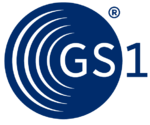Global Product Classification
 |
|
| Not-for-profit organisation | |
| Industry | Standards |
| Founded | 26 April 1974 |
| Headquarters | Brussels, Belgium |
|
Number of locations
|
More than 112 offices worldwide |
|
Key people
|
Miguel A. Lopera (CEO) |
| Website | www |
GS1 is a not-for-profit organisation that develops and maintains global standards for business communication. The best known of these standards is the barcode, a symbol printed on products that can be scanned electronically. GS1 barcodes are scanned more than six billion times every day.
GS1 has 112 local Member Organisations and 1.5 million user companies.
GS1 standards are designed to improve the efficiency, safety and visibility of supply chains across physical and digital channels in 25 sectors. They form a business language that identifies, captures and shares key information about products, locations, assets and more.
In 1969, the retail industry in the US was searching for a way to speed up the check-out process in shops. The Ad Hoc Committee for a Uniform Grocery Product Identification Code was established to find a solution.
In 1973, the Universal Product Code (U.P.C.) was selected by this group as the first single standard for unique product identification, and in 1974, the Uniform Code Council (UCC) was founded to administer the standard. On 26 June 1974, a pack of Wrigley’s chewing gum became the first ever product with a barcode to be scanned in a shop.
In 1976, the original 12-digit code was expanded to 13 digits, which opened the doors for the identification system to be used outside the U.S. In 1977, the European Article Numbering Association (EAN) was established in Brussels and with founding members from 12 countries.
In 1990, EAN and UCC signed a global cooperation agreement and expanded overall presence to 45 countries. In 1999, EAN and UCC launched the Auto-ID Centre to develop Electronic Product Code (EPC) enabling GS1 standards to be used for RFID.
In 2004, EAN and UCC launched the Global Data Synchronisation Network (GDSN), a global, internet-based initiative that enables trading partners to efficiently exchange product master data, was launched.
By 2005, the organisation was present in over 90 countries started to use the name GS1 on a worldwide basis.
The Barcode is the most well-known of the GS1 standards. It is a unique symbol that encodes a product identification number that can be scanned electronically. It enables products to be tracked, processed and stored all around the world.
...
Wikipedia
